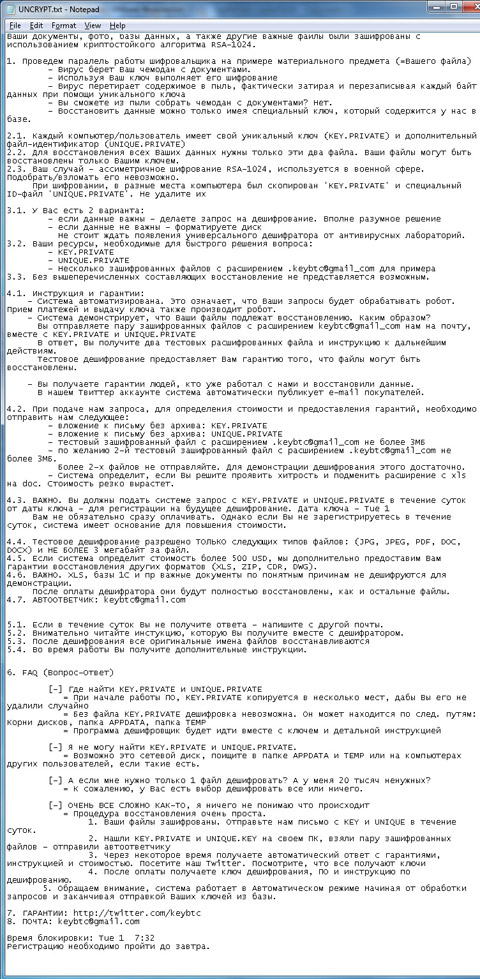BAT_CRYPTOR.C
Windows


Threat Type: Trojan
Destructiveness: No
Encrypted: No
In the wild: Yes
OVERVIEW
Dropped by other malware, Downloaded from the Internet
This Trojan may be downloaded by other malware/grayware from remote sites.
It deletes itself after execution.
TECHNICAL DETAILS
24,227 bytes
BAT
No
31 Oct 2014
Displays ransom note, Renames files
Arrival Details
This Trojan may be downloaded by the following malware/grayware from remote sites:
- JS_DOWNCRYPT.B
It may be downloaded from the following remote sites:
- http://www.{BLOCKED}blog.net/photo/blck.keybtc
Installation
This Trojan drops the following component file(s):
- %User Temp%\UNCRYPT.txt
- %Application Data%\Desktop\UNCRYPT.txt
- %User Profile%\Desktop\UNCRYPT.txt
- %System Root%\UNCRYPT.txt
- %User Temp%\client.keybtc
- %User Temp%\genpair.keybtc
- %User Temp%\impubkey.keybtc
- %User Temp%\{random}.cmd - used to delete dropped components
(Note: %User Temp% is the user's temporary folder, where it usually is C:\Documents and Settings\{user name}\Local Settings\Temp on Windows 2000, Windows Server 2003, and Windows XP (32- and 64-bit); C:\Users\{user name}\AppData\Local\Temp on Windows Vista (32- and 64-bit), Windows 7 (32- and 64-bit), Windows 8 (32- and 64-bit), Windows 8.1 (32- and 64-bit), Windows Server 2008, and Windows Server 2012.. %Application Data% is the Application Data folder, where it usually is C:\Documents and Settings\{user name}\Application Data on Windows 2000, Windows Server 2003, and Windows XP (32- and 64-bit); C:\Users\{user name}\AppData\Roaming on Windows Vista (32- and 64-bit), Windows 7 (32- and 64-bit), Windows 8 (32- and 64-bit), Windows 8.1 (32- and 64-bit), Windows Server 2008, and Windows Server 2012.. %User Profile% is a user's profile folder, where it usually is C:\Documents and Settings\{user name} on Windows 2000, Windows Server 2003, and Windows XP (32- and 64-bit); C:\Users\{user name} on Windows Vista (32- and 64-bit), Windows 7 (32- and 64-bit), Windows 8 (32- and 64-bit), Windows 8.1 (32- and 64-bit), Windows Server 2008, and Windows Server 2012.. %System Root% is the Windows root folder, where it usually is C:\ on all Windows operating system versions.)
Other System Modifications
This Trojan deletes the following files:
- %User Temp%\*.gpg
- %User Temp%\*.lock
- %User Temp%\*.keybtc
- %Application Data%\gnupg\*.*
- %User Temp%\random_seed
- %User Temp%\*.html
- %User Temp%\*.bak
- %User Temp%\svchost.exe
- %User Temp%\*.dll
- %User Temp%\genpair.keybtc
- %User Temp%\impubkey.keybtc
- %User Temp%\secring.gpg
- %User Temp%\secring.gpg.gpg
- %User Temp%\databin.1st
- %User Temp%\bindata.cmd
- %User Temp%\UNIQUE1.BASE
(Note: %User Temp% is the user's temporary folder, where it usually is C:\Documents and Settings\{user name}\Local Settings\Temp on Windows 2000, Windows Server 2003, and Windows XP (32- and 64-bit); C:\Users\{user name}\AppData\Local\Temp on Windows Vista (32- and 64-bit), Windows 7 (32- and 64-bit), Windows 8 (32- and 64-bit), Windows 8.1 (32- and 64-bit), Windows Server 2008, and Windows Server 2012.. %Application Data% is the Application Data folder, where it usually is C:\Documents and Settings\{user name}\Application Data on Windows 2000, Windows Server 2003, and Windows XP (32- and 64-bit); C:\Users\{user name}\AppData\Roaming on Windows Vista (32- and 64-bit), Windows 7 (32- and 64-bit), Windows 8 (32- and 64-bit), Windows 8.1 (32- and 64-bit), Windows Server 2008, and Windows Server 2012.)
It adds the following registry entries:
HKEY_CURRENT_USER\Software\Microsoft\
Windows\CurrentVersion\Run
WinHelp = "%User Temp%\UNCRYPT.txt"
Other Details
This Trojan encrypts files with the following extensions:
- .mdb
- .rtf
- .accdb
- .slddrw
- .zip
- .rar
- .max
- .jpg
- .xls
- .xlsx
- .doc
- .docx
- .cdr
- .dwg
- .1cd
- .cd
It requires the following additional components to properly run:
- %User Temp%\query.kbtc
- %User Temp%\trsh.kbtc
(Note: %User Temp% is the user's temporary folder, where it usually is C:\Documents and Settings\{user name}\Local Settings\Temp on Windows 2000, Windows Server 2003, and Windows XP (32- and 64-bit); C:\Users\{user name}\AppData\Local\Temp on Windows Vista (32- and 64-bit), Windows 7 (32- and 64-bit), Windows 8 (32- and 64-bit), Windows 8.1 (32- and 64-bit), Windows Server 2008, and Windows Server 2012.)
It renames encrypted files using the following names:
- {file name and extension}.keybtc@gmail_com
It deletes itself after execution.
NOTES:
This malware renames the following files as follows:
- %User Temp%\query.kbtc to %User Temp%\svchost.exe - gpg application (non-malicious)
- %User Temp%\trsh.kbtc to %User Temp%\sdelete.exe - sysinternals sdelete (non-malicious)
- %User Temp%\UNIQUE1.BASE.gpg to %User Temp%\UNIQUE.PRIVATE
- %User Temp%\bitdatal.bin to %User Temp%\bindata.cmd
This Trojan opens the user's default browser and displays the following site:
- http://j.{BLOCKED}p/{BLOCKED}ybtc
However, the site is no longer available.
It opens the file UNCRYPT.txt which contains the ransom note :

SOLUTION
9.700
Step 1
Before doing any scans, Windows XP, Windows Vista, and Windows 7 users must disable System Restore to allow full scanning of their computers.
Step 2
Delete this registry value
Important: Editing the Windows Registry incorrectly can lead to irreversible system malfunction. Please do this step only if you know how or you can ask assistance from your system administrator. Else, check this Microsoft article first before modifying your computer's registry.
- In HKEY_CURRENT_USER\Software\Microsoft\Windows\CurrentVersion\Run
- WinHelp = "%User Temp%\UNCRYPT.txt"
- WinHelp = "%User Temp%\UNCRYPT.txt"
Step 3
Scan your computer with your Trend Micro product to delete files detected as BAT_CRYPTOR.C. If the detected files have already been cleaned, deleted, or quarantined by your Trend Micro product, no further step is required. You may opt to simply delete the quarantined files. Please check this Knowledge Base page for more information.
Did this description help? Tell us how we did.
